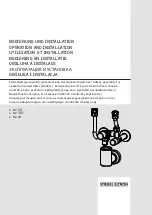
36
6
COMMISSIONING THE UNIT
AND THE
INSTALLATION
6.1
Filling and air purge of unit and installation
6.1.1
CH system
1.
Insert the unit's plug into a socket.
The unit may carry out a self-check:
2
(on service display).
The unit will then go into the off setting:
-
(on service display) and the CH
pressure is shown on the temperature display.
In case of a CH pressure lower than 0.5 bar, the CH
pressure will be displayed flashing on the display.
In the off setting, the CH pressure will be displayed.
2.
Connect the filling hose to the fill/drain tap and fill the installation with clean
drinking water, up to a pressure between 1 and 2 bar if the installation is cold
(to be read from the temperature display).
3.
Aerate the system with the manual aerator (A).
Upon request, an automatic aerator can be fitted onto the unit instead of the
manual aerator.
4.
Aerate the installation with the manual aerators on the radiators.
5.
Top up the CH installation if the pressure has dipped too low due to the
aeration.
6.
Check all couplings for leaks.
7.
Check whether the siphon is filled with water.
WARNING
If the siphon is not filled with water, combustion gases may
be released into the room.
WARNING
If an additive is added to the CH water, it must be suitable for
the materials used in the unit, such as copper, brass,
stainless steel, steel, plastic and rubber. The additive should
preferably have a KIWA/ATA/Atest certification.
6.1.2
DHW provision
1.
Open the main tap to bring the DHW section up to pressure.
2.
Aerate the exchanger and the pipe system by opening a DHW tap.
Leave the tap open until all air has flowed out of the system.
3.
Check all couplings for leaks.
6.1.3
Gas supply
1.
Aerate the gas pipe with the initial pressure measuring nipple (D) on the gas
block.
2.
Check all couplings for leaks.
3.
Check the initial pressure and offset pressure (see par. 7.7).
















































